| Arieticeras Temporal range: | |
|---|---|
 | |
| Specimens | |
| Scientific classification | |
| Kingdom: | |
| Phylum: | |
| Class: | |
| Subclass: | |
| Genus: | Arieticeras |
Arieticeras is an extinct genus of cephalopod belonging to the Ammonite subclass.
| Arieticeras Temporal range: | |
|---|---|
 | |
| Specimens | |
| Scientific classification | |
| Kingdom: | |
| Phylum: | |
| Class: | |
| Subclass: | |
| Genus: | Arieticeras |
Arieticeras is an extinct genus of cephalopod belonging to the Ammonite subclass.

Goniatites is a genus of extinct cephalopods belonging to the family Goniatitidae, included in the superfamily Goniatitaceae. Hibernicoceras and Hypergoniatites are among related genera.
Joseph John Sepkoski Jr. was a University of Chicago paleontologist. Sepkoski studied the fossil record and the diversity of life on Earth. Sepkoski and David Raup produced a new understanding of extinction events, by developing a statistical approach to the study of taxonomic diversification. He suggested that the extinction of dinosaurs 66 mya was part of a cycle of mass extinctions that may have occurred every 26 million years. But his most important contribution was the identification of the "Big 5" mass extinctions, events that have shaped the evolution of life on earth.
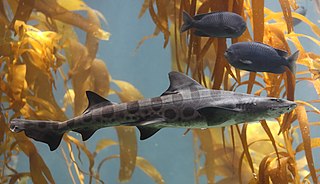
Triakis is a genus of houndsharks in the family Triakidae. The name comes from the Ancient Greek word τρι- meaning 'three', and the Latin word acis meaning 'sharp' or 'pointed', in reference to their three-pointed teeth.
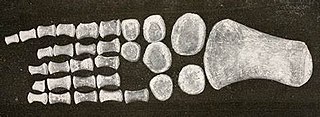
Ogmodirus is an extinct genus of plesiosaur found in the Cenomanian-Turonian Greenhorn Limestone of Kansas. The type species, O. martini, was named by Samuel Wendell Williston and Roy Lee Moodie in 1913.
Sundayichthys is an extinct genus of prehistoric bony fish that lived during the Carboniferous period in what is now South Africa. Fossils were recovered from the Upper Witteberg Series.

Clymeniida is an order of ammonoid cephalopods from the Upper Devonian characterized by having an unusual dorsal siphuncle. They measured about 4 cm (1.6 in) in diameter and are most common in Europe, North Africa, and South China but are known from North America and Australia as well.

Phylloceras is an extinct genus of ammonoid cephalopods belonging to the family Phylloceratidae. These nektonic carnivores lived from Early Jurassic to Late Cretaceous.
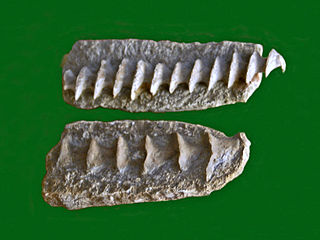
Archimedes is a genus of bryozoans belonging to the family Fenestellidae. The first use of the term "Archimedes" in relation to this genus was in 1838.

Tarasiiformes is an extinct order of prehistoric ray-finned fish.

Macroscaphites is an extinct cephalopod genus included in the Ammonoidea that lived during the Barremian and Aptian stages of the Early Cretaceous. Its fossils have been found throughout most of Europe and North Africa.

Calycoceras is an extinct genus of cephalopods belonging to the subclass Ammonoidea and family Acanthoceratidae that lived during the Cenomanian stage of the Late Cretaceous, 100-94 Mya. Their shells had ornate ribs.
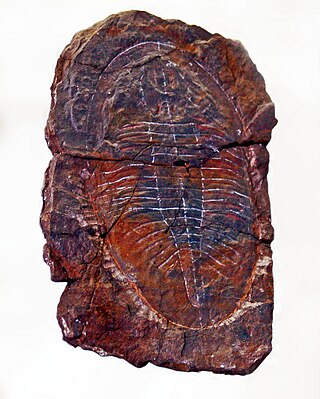
Birmanites is a genus of trilobites in the order Asaphida, family Asaphidae.

Belemnites is a genus of an extinct group of cephalopods belonging to the order Belemnitida. These cephalopods existed in the Early Jurassic period from the Hettangian age to the Toarcian age (175.6–183.0). They were fast-moving nektonic carnivores.

Strophomena is a genus of brachiopods belonging to the order Strophomenida family Strophomenidae, named by Rafinesque in 1824. They were stationary epifaunal suspension feeders.

Ampullina is an extinct taxonomic genus of deep-water sea snails, marine gastropod molluscs in the clade Caenogastropoda. These sea snails were epifaunal grazers. They lived from the Middle Triassic period to the Lower Pliocene age.

Lopha is a genus of marine bivalve molluscs in the family Ostreidae.
Neophylloceras is an extinct genus of cephalopod belonging to the Ammonite subclass.
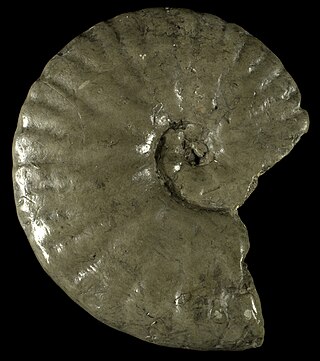
Metoioceras is an extinct genus of cephalopod belonging to the Ammonite subclass which lived during the Cenomanian.

Dufrenoyia is an extinct genus of Cretaceous ammonites included in the family Parahoplitidae. These fast-moving nektonic carnivores lived in the Cretaceous period. The type species of the genus is Ammonites dufrenoyi.